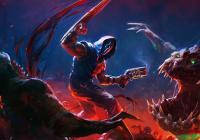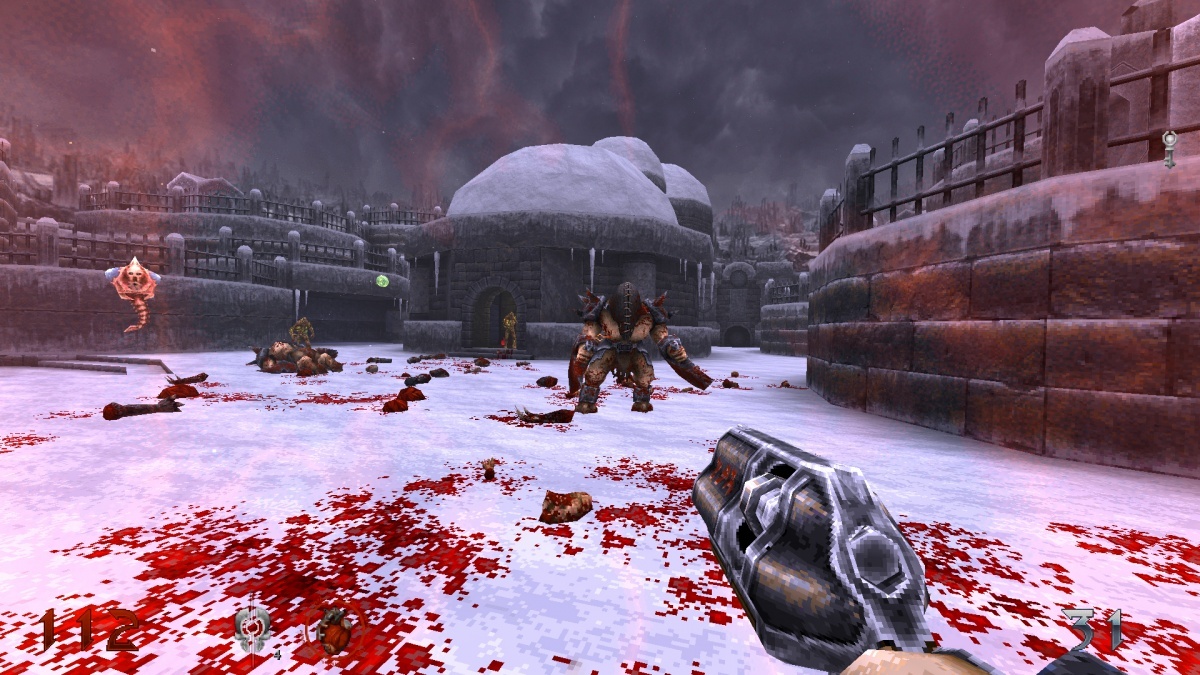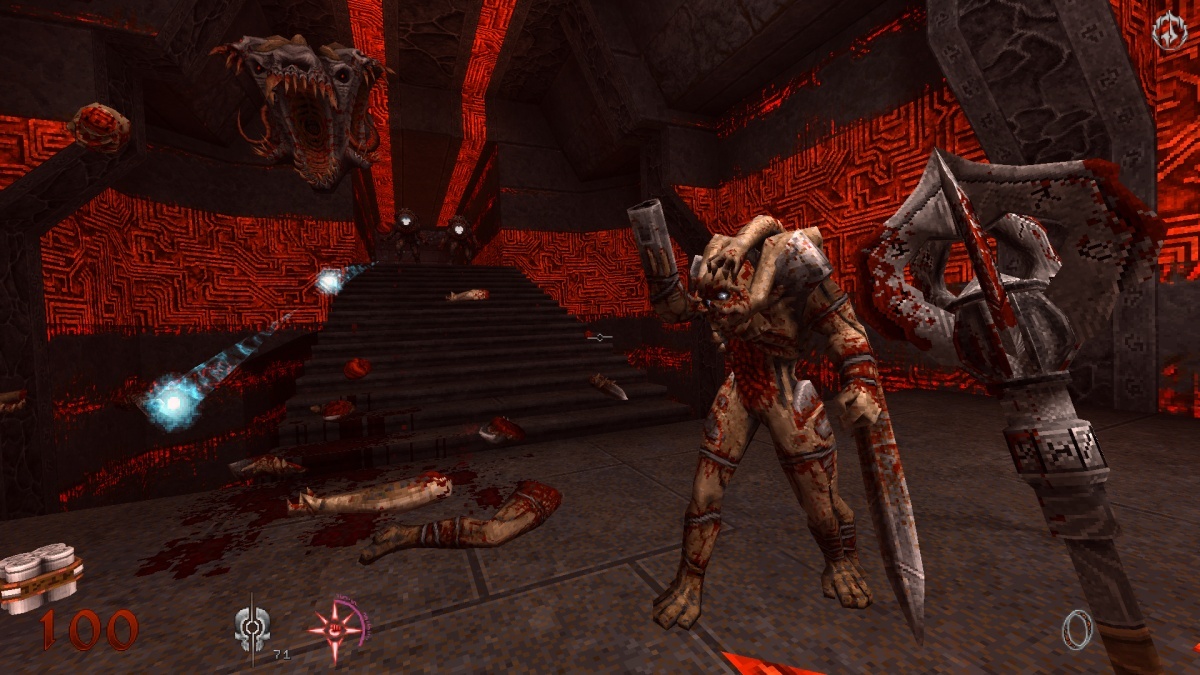WRATH: Aeon of Ruin (PC) Review
By Athanasios  10.11.2024
10.11.2024

A long time has passed since indie/retro FPS lovers first laid eyes upon the very promising WRATH: Aeon of Ruin, something which made many believe that it was stuck in development hell - which was kind of true. Thankfully, and unlike the other promising shooter GRAVEN, which turned out to be a major disappointment (at best), 3D Realms' Quake-powered homage to… err, Quake, is a great, old-but-new, first-person experience. This action-packed, dark fantasy trip has a couple of flaws that keep it from being the masterpiece that it could very easily be, but it's also a cult classic in disguise, that many fans of the recent wave of old school-inspired, retraux shooters will adore.
A boat-coffin (or coffin-boat) travels in the tranquil, cosmic ocean that is the Ageless Sea. Within it lies the Outlander. This masked warrior arrived at the Isle of the Dead, and guided by a mysterious figure, he will brave snow-filled realms with imposing fortresses, swamplands with titanic trees, dark dungeons were undead roam, trap-filled, ancient temples, and quite fittingly for something running in slightly altered Quake juice, metal-meets-flesh hellscapes. He will battle against walking corpses, monsters of flesh and teeth, gigantic beasts that spit acid, mutants with shotguns for hands, eldritch abominations, and corrupt deities that will be brought down from their thrones.
WRATH: Aeon of Ruin looks awesome, and in a way that will please the 15-year-old metalhead within you. No scantily clad, busty dominatrix witches to be found here, but you can't have everything. This trip back to the late '90s reeks of old school charm and in a very authentic way, however, the team behind this didn't just make it look retro and left it at that. Like a mix between Quake and HeXen, the action is super-fast, battles fill the ground with meat chunks, the weapons are aplenty, and they sound and feel powerful. Right besides all that carnage, however, the maps are enormous and quite mazy, built for those who love exploring all over the place in search of secrets.

The atmosphere is spot on, making the many quitter moments feel quite immersive. Sure, this won't win any awards for its original design. There are certain moments where the scenery can even be called generic - stuff you've seen a hundred times. It is the beautiful kind of generic, though. Like a piece of fantasy art you've found on the Internet, you might have seen similar stuff already, but you still like what you see. That's a good thing because this is a pretty epic adventure. Don't expect to reach the end within a few days. The maps are large. Maybe too large, as they can occasionally devour a whole hour - more if you are searching for secrets.
Each stage is filled with all sorts of twists and turns, openings that lead back to previously traversed areas, and the use of vertical space is spectacular and puts mainstream FPS games to shame. You basically traverse a Dark Souls locale, but instead of a claymore you are carrying a shotgun. Of course, the vast map sizes can get tiring. This generally has a thing for big numbers. Each of the three hub worlds links to five gargantuan levels, although many among them are similar in look and theme, and could therefore be limited to three. Also, why oh why is there a need for more than 300 enemies per stage? Why have more than 10-15 secrets to search for, when five good ones could easily suffice? The scale is part of the fun here, but it's certainly not for everyone.

The game's lack of restraint can also be seen in the way enemies have been handled. Apart from the fact that they spawn in large groups almost every time… anything happens, almost all of them spit - fast - projectiles a bit too passionately. The Wretch, for instance, starts shooting blue plasma ball after blue plasma ball the moment the Outlander shows an inch of his body. That critter appears so often that players will hear their distinctive sound in their sleep. At least all enemies are kind of dumb, and players can simply exploit their simplistic AI, and lead them where they want. Not that this is enough to make this a walk in the park…
While not a particularly hard, the challenge is certainly high - occasionally in an annoying way, due to the almost constant rain of fire when combating a team of mobs. Genre veterans won't die that often, even in the highest difficulty mode, but it's almost impossible to keep your hard-earned armour points (and some of your health) for more than five minutes. There are super-fast monsters like the Widow that come out of their hiding place and move and attack incredibly fast; foes like the Invader who can snipe the hero from across a large distance, and with bullets that can rarely be dodged; bullet sponges like the Cacodemon-on-steroids Heretic that showers you with projectiles and eats your face when you get to close, and so on and forth.

At times it feels as your very powers are against you or simply not made for this game. As an example, the Outlander’s main tool of the trade, the very Heavy Metal-sounding Ruination Blade one-shots most enemies, yet at least three types do damage upon death, or are able to hit in milliseconds when close. Also, like in the Early Access, the walking speed is really a running speed, and the running speed is actually a ridiculously fast sprinting speed, with the first being too slow for such a fast-paced shooter, while the latter feels “slippery,” making it hard to aim property, or avoid falling down to a pool of liquid hot magma. If you’ve played DOOM Eternal then you probably remember how similarly aggravating it could be at times. Then it all clicks, and it becomes the best first-person shooter you’ve ever played.
The same happens with WRATH. Well… it doesn’t become “the best first-person shooter,” but somehow, after some time of playing, you simply realise what needs to be done, and thus start having tons of fun. You learn when to run and when to sprint, when and how to exploit the weakness of this or that enemy, and, most of all, you realise that you are meant to constantly switch weapons depending on the situation, going back and forth between them, using their secondary attack modes, and mixing in the Ruination Blade when needed to quickly cut through the opposition like hot butter, or to move around quicker with its neat forward dash attack. Moving around and shooting at bad things is just so darn enjoyable, to the point that you forget how repetitive this can get due to its overblown length.

The available arsenal doesn’t reinvent the wheel. In fact, what we have here are slightly altered versions of the typical FPS weaponry, yet each one of them feels good when pulling the trigger, and has its own unique purpose depending on the combat scenario. As an extra source of fun, the Outlander can find Artefacts; temporary abilities that last about 15 seconds, and with which he can heal by killing enemies, turn on a temporary god mode that drops his health to 1HP, make his opponents kill each other, and many more. To be honest one can almost forget their existence up to the point that your inventory is full of them and you just “have to” use them, but they can surely help out in the many tricky spots when you are surrounded by a variety of pretty tough baddies.
Now, here’s the important bit. Taking a look at the trailer will have most think that this is an uber-bombastic shooter; a DOOM on a budget kind of deal… but this isn’t really what WRATH is. Don’t expect 7-string guitars blasting while you frag monsters to pieces. This is actually a lot slower paced than expected, and has a dark, ethereal atmosphere that’s hard to put on - digital - paper, with Andrew Hulshult’s moody, simple-yet-effective assortment of tunes increasing it by tenfold. You are supposed to let yourself get absorbed into this post-apocalyptic world; to stop, and smell the dying flowers. Yes, the Outlander’s bloody quest is filled with bloody action, but there’s more to it than that. Enter exploration. Exit free time.

Ok, back to the Ruination Blade. This handy tool is super helpful in dispatching enemies, but as mentioned before its secondary dash move can propel you forward, and essentially do a double jump helping the Outlander reach higher places. There’s a decent amount of platforming involved. It’s fun but nothing that exciting or hard to pull off. Unless you are searching for the 150 to 200 secrets that are scattered all around, that is! The rewards? Some extra armour points, an additional Artefact, more ammo, etc. The real joy is actually in finding them... and trying to not pull your hair out.
There’s at least one secret per map that can drive you nuts, either because it’s extra well-hidden, or due to how the acrobatics one will need to pull off are insane. If you are a PC user with stress issues, the Mark of Revelation artefact, as well as the noclip command (read: cheat) will become your new best friend. A very important word of caution for completionists: once you move passed a hub, it is done - no way to go back, which is a big oversight on behalf of the developers for such a lengthy ordeal where part of the fun is searching for secrets. The same applies to the coffers that can be found in each map. They are essentially secrets too, but for some strange reason they don’t count as one, so it’s easy to miss them, go to the next hub, and miss your chance to find them all.

One final thing before this reviewer returns to his fourth completionist run: WRATH doesn’t have unlimited saves. Well, it has, but that’s actually an option literally created for those who hated how saves are a finite, collectible item. In reality the default limitation perfectly increases the tension, forcing players to think whether to record their progress, or risk losing it all by saving later. 10 lost minutes of progress in such long maps can drive anyone insane, but it also forces the one pushing all the buttons to pay full attention to what’s on screen, and think before acting instead of just spamming a quick save button. In other words, it increases engagement, especially in the Outlander difficulty mode where you can’t store more than three of these items in your pocket.
To conclude, WRATH: Aeon of Ruin is a great FPS that leans heavily into the past, offering a marvellously retro adventure, yet at the same time having its own unique identity, look, and feel. It’s kind of a niche pick, though. It offers a very specific taste that will please some and annoy others - heck, it’s passion with scale can annoy even the ones that actually love it. Yes, it lasts longer than it should, is somewhat repetitive, some sections can irritate tremendously, it has some balance issues, and it could do with some minor tweaking here and there, but as a whole it’s one of the finest games of its kind. Again, as long as you aren’t here just to shoot some guns.

Cubed3 Rating
Great - Silver Award

Almost every single one of the so-called "boomer shooters" tends to focus almost entirely on fast, high-octane action. WRATH: Aeon of Ruin fools you by thinking it's the same as them but it isn't. Oh, sure, it has plenty combat to satiate your need for killing evil things with cool weapons, but you are also meant to soak into its strong dark fantasy atmosphere, and spend hours exploring its beautiful, vast realms. While it has its flaws, with chief among them its needlessly large maps, it's safe to call this trip back to the magic of the past a modern classic of the genre.

![]() 8/10
8/10
![]() 0
(0 Votes)
0
(0 Votes)
 Out now
Out now  Out now
Out now  Out now
Out now  Out now
Out now Comments
Comments are currently disabled

 Sign In
Sign In Game Details
Game Details Subscribe to this topic
Subscribe to this topic Features
Features





 Top
Top

